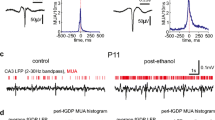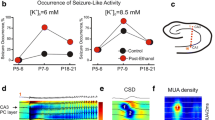Abstract
Maternal hyperhomocysteinemia (HHCy) correlated with a number of complications such as abruption placentae, preeclampsia syndrome, in utero fetal death and fetal neural tube defects, cognitive impairment, and neurodegeneration during postnatal development. In the present study, we investigated the effects of prenatal HHCy on electrophysiological features and spontaneous network activity of neurons in hippocampus of rats of the first postnatal week. The analysis of intrinsic electrophysiological properties of pyramidal neurons has shown the decrease of the membrane capacitance and the threshold of generation of action potentials in rats with prenatal HHCy without alteration of the input resistance and resting membrane potential. In trains of action potentials elicited with prolonged current injections, an increase of interspike intervals and a broadening of action potentials during repetitive firing were observed in control neurons. In the neurons of pups with prenatal HHCy, the changes in interspike intervals were not significant and the broadening of action potentials in train was less pronounced. Using extracellular field potential recordings from the hippocampal slices, we found that the network activity in hippocampal slices from rats with prenatal HHCy displayed several abnormalities including the increase in overall neuronal firing and reduction of frequency of giant depolarizing potentials in CA3 regions. We conclude that the increased neuronal excitability and impairment of network activity in hippocampus can underlie neurodevelopmental abnormalities and hyperexcitability in prenatal HHCy.


Similar content being viewed by others
References
Troen, A. M. (2005). The central nervous system in animal models of hyperhomocysteinemia. Progress in Neuro-Psychopharmacology & Biological Psychiatry, 29(7), 1140–1151.
Perla-Kajan, J., Twardowski, T., & Jakubowski, H. (2007). Mechanisms of homocysteine toxicity in humans. Amino Acid, 32(4), 561–572.
Welchv, G. N., & Loscalzo, J. (1998). Homocysteine and atherothrombosis. The New England Journal of Medicine, 338(15), 1042–1052.
Boldyrev, A. (2009). Molecular mechanisms of homocysteine toxicity and possible protection against hyperhomocysteinemia. Biochemistry (Moscow), 74, 589–598.
Lutz, U. C. (2008). Alterations in homocysteine metabolism among alcohol dependent patients—clinical pathobiochemical and genetic aspects. Current Drug Abuse Reviews, 1, 47–55.
Langmeier, M., Folbergrova, J., Haugvicova, R., Pokorny, J. L., & Mares, P. (2003). Neuronal cell death in hippocampus induced by homocysteic acid in immature rats. Epilepsia, 44(3), 299–304.
Gaifullina, A. S., Yakovlev, A. V., Mustafina, A. N., Weiger, T. M., Hermann, A., & Sitdikova, G. F. (2016). Homocysteine augments BK channel activity and decreases exocytosis of secretory granules in rat GH3 cells. FEBS Letters, 590, 3375–3384.
Makhro, A. V., Mashkina, A. P., Solenaya, O. A., Trunova, O. A., Tyulina, O. V., Bulygina, E. R., & Boldyrev, A. A. (2008). Carnosine protects cells from oxidative stress induced by hyperhomocysteinemia. Neurochemical Journal, 2(3), 202–208.
Abushik, P. A., Niittykoski, M., Giniatullina, R., Shakirzyanova, A., Bart, G., Fayuk, D., Sibarov, D. A., Antonov, S. M., & Giniatullin, R. (2014). The role of NMDA and mGluR5 receptors in calcium mobilization and neurotoxicity of homocysteine in trigeminal and cortical neurons and glial cells. Journal of Neurochemistry, 129(2), 267–274.
Algaidi, S. A., Christie, L. A., Jenkinson, A. M., Whalley, L., Riedel, G., & Platt, B. (2006). Long-term homocysteine exposure induces alterations in spatial learning, hippocampal signalling and synaptic plasticity. Experimental Neurology, 197(1), 8–21.
Schaub C, Uebachs M, Beck H,·Linnebank M (2013) Chronic homocysteine exposure causes changes in the intrinsic electrophysiological properties of cultured hippocampal neurons. Experimental Brain Research, 225, 527–534.
Arutjunyan, A., Kozina, L., Stvolinskiy, S., Ye, B., Mashkina, A., & Khavinson, V. (2012). Pineal on protects the rat offspring from prenatal hyperhomocysteinemia. International Journal of Clinical and Experimental Medicine, 5(2), 179–185.
Gerasimova, E., Yakovleva, O., Burkanova, G., Ziyatdinova, G., Khaerdinov, N., & Sitdikova, G. (2017). Effects of maternal hyperhomocysteinemia on the early physical development and neurobehavioral maturation of rat offspring. BioNanoScience, 7, 155–158.
Baydas, G., Koz, S. T., Tuzcu, M., Nedzvetsky, V. S., & Etem, E. (2007). Effects of maternal hyperhomocysteinemia induced by high methionine diet on the learning and memory performance in offspring. International Journal of Developmental Neuroscience, 25, 133–139.
Blaise, S. A., Nédélec, E., Schroeder, H., Alberto, J. M., Bossenmeyer-Pourié, C., Guéant, J. L., et al. (2007). Gestational vitamin B deficiency leads to homocysteine-associated brain apoptosis and alters neurobehavioral development in rats. The American Journal of Pathology, 170(2), 667–679.
Kress, G. J., Dowling, M. J., Meeks, J. P., & Mennerick, S. (2008). High threshold, proximal initiation, and slow conduction velocity of action potentials in dentate granule neuron mossy fibers. Journal of Neurophysiology, 100(1), 281–291.
Lee, P. T., Lowinsohn, D., & Compton, R. G. (2014). Simultaneous detection of homocysteine and cysteine in the presence of ascorbic acid and glutathione using a nanocarbon modified electrode. Electroanalysis, 26, 1488–1496.
Ben-Ari, Y., Khalilov, I., Kahle, K. T., & Cherubini, E. (2012). The GABA excitatory/inhibitory shift in brain maturation and neurological disorders. The Neuroscientist, 18(5), 467–486.
Sanchez, J. T., Wang, Y., Rube, E. W., & Barria, A. (2010). Development of glutamatergic synaptic transmission in binaural auditory neurons. Journal of Neurophysiology, 104(3), 1774–1789.
Bandeira, F., Lent, R., & Herculano-Houzel, S. (2009). Changing numbers of neuronal and non-neuronal cells underlie postnatal brain growth in the rat. PNAS, 106(33), 14108–14113.
Mukhamedyarov, M. A., Minlebaev, M. G., & Zefirov, A. L. (2004). Effect of blockers of potential-dependent and calcium-activated K+-channels on facilitation of neuromuscular transmission. Bulletin of Experimental Biology and Medicine, 137(4), 323–326.
Zakharov, A., Lotfullina, N., & Khazipov, R. (2017). Impairments to the giant depolarizing potentials after the third trimester equivalent ethanol exposure in the neonatal rat. BioNaoScience, 6(4), 523–527.
Bolton, A. D., Phillips, M. A., & Constantine-Paton, M. (2013). Homocysteine reduces NMDAR desensitization and differentially modulates peak amplitude of NMDAR currents, depending on GluN2 subunit com- position. Journal of Neurophysiology, 110, 1567–1582 2013Sibarov 2017.
Sibarov DA, Abushik PA, Giniatullin R, Antonov SM (2017) GluN2A subunit-containing NMDA receptors are the preferential neuronal targets of homocysteine. Frontiers in Cellular Neuroscience, 10(246), https://doi.org/10.3389/fncel.2016.00246.
Chang, L. R., Liu, J. P., Zhang, N., Wang, Y. J., Gao, X. L., & Wu, Y. (2009). Different expression of NR2b and PSD-95 in rat hippocampal subregions during postnatal development. Microscopy Research and Technique, 72, 517–524.
Funding
This work was supported by Russian Science Foundation no. 14-15-00618.
Author information
Authors and Affiliations
Corresponding author
Rights and permissions
About this article
Cite this article
Yakovlev, A.V., Kurmashova, E., Zakharov, A. et al. Network-Driven Activity and Neuronal Excitability in Hippocampus of Neonatal Rats with Prenatal Hyperhomocysteinemia. BioNanoSci. 8, 304–309 (2018). https://doi.org/10.1007/s12668-017-0450-y
Published:
Issue Date:
DOI: https://doi.org/10.1007/s12668-017-0450-y




